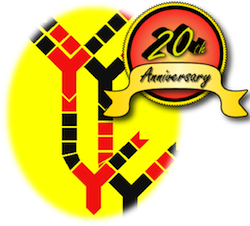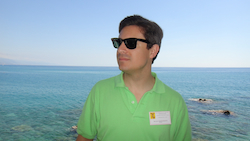The International Advanced Workshop on High Performance Computing, Grids and Clouds (HPC 2012) took place in Cetraro, Italy, serving again as a meeting point for ideas pertaining to HPC, distributed computing, and beyond. This year’s event, held from June 25-29, was particularly significant because HPC 2012 was celebrating its 20th anniversary! And yes, I had the honor to witness and participate in this historic gathering.
 HPC Where, When and How
HPC Where, When and How
Every two years, the HPC Workshop takes place to shed light on key topics in advanced high performance computing systems. Last week, experts in the field accomplished this with about forty invited talks.
The venue has been always the same: Gran Hotel San Michele, located in Cetraro, Italy. The hotel shares the charm of one of the most beautiful places in South Italy.
The founder of this Workshop is Professor Lucio Grandinetti from Università della Calabria. His incredible work, dedication and passion have led to the most renowned experts in the field taking part year after year.
By the way, NATO funded the first and third editions (1992 and 1996). This interesting fact shows how the interest in HPC has grown in Europe.
The Talks
Speaking the social networking language of the day, we can say that the “trending topics” (aside from HPC proper) were mainly three-fold: “HPC Cloud”, “Big Data” and “Green IT”. The variety of both the content of the talks and the background of the attendees was so rich that discussions extended beyond the conference hall doors.
As a matter of fact, the quality of this year’s event “hit the clouds”. Here is just a small sampling of what was available with a focus on cloud, of course. Additional information on all the sessions is available here.
Jack Dongarra: “On the Future of High Performance Computing: How to Think for Peta and Exascale Computing”
Professor Dongarra examined how high performance computing has changed over the last ten years and looked toward the future in terms of trends. These changes have had and will continue to have a major impact on our software. Some of the software and algorithm challenges have already been encountered, such as management of communication and memory hierarchies through a combination of compile-time and run-time techniques, but the increased scale of computation, depth of memory hierarchies, range of latencies, and increased run-time environment variability will make these problems much harder.
In this context, Professor Dongarra focused on the redesign of software to fit multicore and hybrid architectures, automatically tuned application software, exploitation of mixed precision for performance, the importance of fault tolerance and communication avoiding algorithms.
Ian Foster: “Big Process for Big Data”
After the great progress over the past decade toward effectively harnessing the collective power of IT resources distributed across the globe, Professor Foster identified a far greater challenge: researchers will soon require capabilities not so different from those used by these big-science teams.
During the talk, he described the work his team is doing at the Computation Institute at the Argonne National Laboratory to offer researchers a solution, focusing initially on research data lifecycle management. Professor Foster presented promising results obtained to date with the Globus Online system, and suggested a path toward large-scale delivery of these capabilities.
Geoffrey Fox: “Scientific Computing Supported by Clouds, Grids and Exascale Systems“
Professor Fox analyzed scientific computing into classes of applications and their suitability for different architectures covering both compute and data analysis cases and both high end and long tail users. Then, he proposed an architecture for next generation cyberinfrastructure and outlined some of the research challenges. Dr. Fox is the principal investigator for the Indiana University-led Future Grid. This high-performance grid test bed will allow scientists to collaboratively develop and test innovative approaches to parallel, grid, and cloud computing.
Kenji Takeda: “Cloud computing for research and innovation“
This talk addressed how cloud computing is challenging the way we think about parallel and distributed computing, particularly in the context of HPC and the Grid. In particular, Takeda discussed how the community has been exploring the use of cloud computing, including through the European Union Framework Programme 7 VENUS-C project, and the global Azure Research Engagement Programme.
Wolfgang Gentzsch: “Fujitsu and the HPC Pyramid“
Dr. Gentzsch provided an overview of Fujitsu’s HPC solution portfolio, from top-end supercomputing, to mid-market HPC, and technical cloud computing. He demonstrated how Fujitsu, as the world’s third-largest IT services provider, has driven innovation in high performance computing for industry and research.
Marian Bubak: “Environments for Collaborative Applications on e-Infrastructures”
This talk evaluated a few approaches to development and execution of e-science applications on currently available e-infrastructures like grids and clouds. In this context, the WS-VLAM workflow system was presented. This system aims at covering the entire life cycle of scientific workflows: end-users are able to share workflows, reuse each other workflow components, and execute workflow on resources across multiple organizations.
Also, GridSpace was presented. GridSpace is a novel virtual laboratory framework enabling to conduct virtual experiments on grid-based infrastructures. It facilitates exploratory development of experiments by means of scripts that can be expressed in a number of popular languages, including Ruby, Python and Perl. One of most demanding applications are those from the area of Virtual Physiological Human.
Vladimir Getov: “Cloud Adoption Issues: Interoperability and Security“
Prof. Getov addressed the issues behind common cloud concepts such as hybrid infrastructures, where it can be said that the entire cloud pertains to the user with all the subsequent issues. With this in mind, the talk was invitation to discuss the factors that may lead to the “true” hybrid cloud. This come along with the need to see a global consensus on regulation and standards to increase trust in this technology and lower the risks that many organizations feel goes hand-in-hand with entrusting key data or processing capabilities to third parties.
Patrick Martin: “Qos-Aware Management of Cloud Applications“
Professor Martin proposed a framework for QoS-aware management of cloud applications to address the challenges that arise when selecting a cloud provider. He discussed the structure of this framework and highlighted the key research questions that must be answered in order to develop it.
Jose Luis Vazquez-Poletti: “Automatic IaaS Elasticity for the PaaS Cloud of the Future“
During my talk I introduced the 4CaaSt European Commission FP7 project and our work there, providing elasticity at IaaS level. In particular I showed our three approaches: cluster management with the OpenNebula virtual infrastructure manager, a proposal for SLAs and service definition, and finally a set of admission control algorithms.
Odej Kao: “Stratosphere – data management on the cloud“
Prof. Kao presented the Nephele system, an execution engine for massive-parallel virtualized environments centered on a programming model of so-called Parallelization Contracts (PACTs). Nephele is part of the large system Stratosphere, which is as generic as map/reduce systems, while overcoming several of their major weaknesses. The focus of the talk was set on the underlying cloud model, the execution strategies, the detection of communication bottlenecks and network topology, and on lightweight fault tolerance methods.
Domenico Talia: “A Cloud Framework for Knowledge Discovery Workflows on Azure“
Prof. Talia introduced a Cloud framework that supports the composition and scalable execution of knowledge discovery applications on the Windows Azure platform. Here we describe the system architecture, its implementation, and current work aimed at supporting the design and execution of knowledge discovery applications modeled as workflows.
Peter Kacsuk: “Executing Multi-workflow simulations on a mixed grid/cloud infrastructure using the SHIWA Technology”
Dr. Kacsuk introduced SHIWA, a technology that makes it possible to share workflows written in various workflow languages among different user communities. It also enables the creation of so-called meta-workflows that combine workflow applications into a higher-level workflow system. The other important feature of the SHIWA technology is the support of multi-DCI (Distributed Computing Infrastructure) execution of these meta-workflows both on various grids and cloud systems. During the talk he described in detail how such meta-workflows can be created and executed on a mixed grid/cloud infrastructure.
Dana Petcu: “Open-source platform-as-a-service: requirements and implementation challenges”
Prof. Petcu explained how open‐source platforms that are currently emerging as middleware build on top of multiple clouds have a high potential to help the development of applications that are vendor agnostic and a click away from the Clouds, and, by this, to boost the migration towards the Clouds. Due to the complexity of such platforms the number of existing solutions is currently low. In this context, she presented a short analysis of the available implementations, including VMware’s Cloud Foundry or Red Hat’s OpenShift, as well as with a special focus on the mOSAIC’s platform, the European Commission FP7 project where she is Scientific Coordinator.
Yoshio Tanaka: “Building Secure and Transparent Inter-Cloud Infrastructure for Scientific Applications”
This presentation described the experiences of the Japanese National Institute of Advanced Industrial Science and Technology (AIST) on building secure and transparent Inter-Cloud infrastructure for scientific applications. This Inter-Cloud infrastructure was realized by cloud interoperation and network virtualization. Cloud interoperation enables sharing of virtual machine images by private and public clouds, i.e. a virtual machine image could be shared by different VM hosting environments including OpenNebula, Rocks, and Amazon EC2. Current status and future issues was presented as well.
Judy Qiu: “Scientific Data Analysis on Cloud and HPC Platforms“
Prof. Qiu introduced the key features of Hadoop and Twister (a MapReduce variant) and then, she discussed important issues of interoperability between HPC and commercial clouds and reproducibility using cloud computing environments.
Alfredo Goldman: “The suitability of BSP/CGM model for HPC on Clouds“
Prof. Goldman provided an overview on how to tackle latency, bandwidth and processor sharing using the BSP (Bulk Synchronous Parallel) in grids and clouds. He also introduced the main advantages of CGM (Coarse Grained Model), where the main goal is to minimize the number of communication rounds, which can have an important impact on BSP algorithms performance. Finally, he presented some preliminary experiments comparing the performance of BSP and MapReduce model.
Wolfgang Gentzsch: “EUDAT – European scientists and data centers turn to big data collaboration“
During his second talk, Dr. Gentzsch highlighted the main objectives of the EUDAT project and its Collaborative Data Infrastructure. He also discussed a set of cross-disciplinary data services designed to service all European research communities, such as safe replication of data sets among different sites, data staging to compute facilities, easy data storage, metadata, single sign-on, and persistent identifiers.
Beniamino Di Martino: “Portability and Interoperability in Clouds: Agents, Semantic and Volunteer computing can help – the mOSAIC and Cloud@Home projects”
Prof. Di Martino offered an overview of the European Commission FP7 project mOSAIC (where he is the Coordinator) and the Italian National Relevance Research project Cloud@Home. This last project aims at implementing a volunteer cloud, a paradigm which mixes aspects of both cloud and volunteer computing.
The Panels
There were two panels during the Workshop and they were massive from both sides (speakers and attendees). This was because the growing interest of their suggesting titles: “Five years into exascale exploration: what have we learned?” and “Cloud Computing and Big Data: Challenges and Opportunities”.
A Very Special Workshop
As explained before, the HPC Workshop started 20 years ago. For this reason the participants wanted to give Professor Lucio Grandinetti a tribute in the form of a gift.
Click to expand
It was a custom-created work of fine art done at the Art Institute of Chicago: a bronze sculpture with stained glass representing the hotel and the sea. Also, it had the following inscriptions: “In honor of Professor Lucio Grandinetti, founder of the International Advanced Research Workshop on High Performance Computing, on the 20th anniversary edition, June 2012”
I have to say it was a very emotive moment, and not only for Professor Lucio Grandinetti but for all the participants!
He joked with the fact that after 20 years, “the Workshop has much evolved and now it seems to be moving to Fine Arts”.
“Under The Cloud Of Cetraro“
The HPC Workshop is a solid value for all connected areas. Quality is the word that defines it the best because all the experts that share their knowledge each edition cannot be wrong.
Whether it’s “evolving to Fine Arts” or not, we should keep an eye on the outcome of this Workshop every two years.
About the Author
 Dr. Jose Luis Vazquez-Poletti is Assistant Professor in Computer Architecture at Complutense University of Madrid (UCM, Spain), and a Cloud Computing Researcher at the Distributed Systems Architecture Research Group. He is (and has been) directly involved in EU-funded projects, such as EGEE (Grid Computing) and 4CaaSt (PaaS Cloud), as well as many Spanish national initiatives.
Dr. Jose Luis Vazquez-Poletti is Assistant Professor in Computer Architecture at Complutense University of Madrid (UCM, Spain), and a Cloud Computing Researcher at the Distributed Systems Architecture Research Group. He is (and has been) directly involved in EU-funded projects, such as EGEE (Grid Computing) and 4CaaSt (PaaS Cloud), as well as many Spanish national initiatives.
From 2005 to 2009, Professor Vazquez-Poletti’s research focused in application porting onto Grid Computing infrastructures, activity that let him be “where the real action was.” These applications pertained to a wide range of areas, from Fusion Physics to Bioinformatics. During this period he achieved the abilities needed for profiling applications and making them benefit of distributed computing infrastructures. Additionally, he shared these abilities in many training events organized within the EGEE Project and similar initiatives.
Since 2010 his research interests lie in different aspects of cloud computing, but always having real life applications in mind, specially those pertaining to the High Performance Computing domain.
Website: http://dsa-research.org/jlvazquez/
Linkedin: http://es.linkedin.com/in/jlvazquezpoletti/






























































